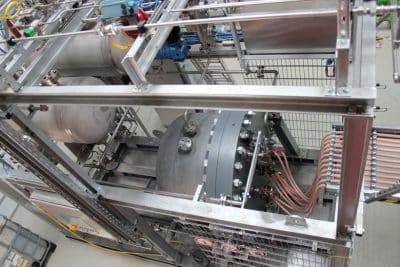Hydrogen is of central importance to a German market that is becoming increasingly interwoven. What makes the gas the ideal chemical energy carrier is that it can provide not only the heat and power sector with a long-term storage option, but also vehicles with electricity and the chemical industry with a raw material. The authors of studies focused on the overall system estimate the requirements in 2050 to total 110 gigawatts for electrolysis through power-to-gas, or, more specifically, power-to-hydrogen, that is, the electrolyte-based production of hydrogen from renewable energies. Their figures also include possible subsequent methanation and a 90 percent reduction in carbon dioxide levels [1].
What size and technical configuration will wind-to-hydrogen systems have in a future sector-integrated energy network? What will their performance be throughout the year? What needs to be done to maximize their economic viability? These were some of the questions raised during WESpe, a joint research initiative. The closing conference that took place Dec. 4, 2017, on the GLS Campus in Berlin provided an opportunity to present key findings to around 80 business delegates, politicians and researchers.
WESpe dealt with the entire energy conversion chain, from renewable resource management and production via electrolysis to storage in underground facilities and injection into natural gas networks to consumption in a variety of sectors. One focus area was electrolysis research. Other objectives were to advance the development of components for underground storage and pipeline injection and to examine the technological and economic aspects of sample pathways that make use of wind-sourced hydrogen.
The overall aim was to improve processes that are critical to a functioning wind-to-hydrogen supply chain. Detailed simulations of the entire energy network were conducted to determine the economic and technological impact of sample power-to-gas systems, particularly when hydrogen is produced. The research consortium chose eight scenarios, including ones that map strategically essential pathways to transform the market. Two such vital paths are, first, widespread hydrogen-based power production and supply in manufacturing by 2050 and, second, medium-term economic viability of the gas in transportation.
Creating the next generation of electrolyzers
The Brandenburg University of Technology, Fraunhofer ISE and the German Aerospace Center studied and compared PEM and alkaline water electrolysis, with a focus on variable load operation. The German Aerospace Center primarily investigated the performance and degradation of PEM electrolyzers that are operated under rapidly changing load conditions or above rated capacity. Data generated from laboratory experiments on several fuel cells of up to 1.5 megawatts of capacity was analyzed to devise strategies for enhancement, or, more specifically, opportunities to reduce costs through increases in performance, efficiency and lifetime. Other important milestones were reached in the creation of gas diffusion layers combining a micro- and macroporous structure and the design of anti-corrosion coatings for bipolar plates. In the end, transient operation was not considered to be posing above-average risks.
The 60-bar, and thus high-pressure, alkaline electrolyzer owned by the Brandenburg University of Technology (see fig. 1) underwent a series of tests based on steady-state and transient load profiles as well as several parameters, such as pressure, temperature, current density and solution circulation rate. Whereas temperatures showed a significant impact on the process, pressure levels had marginal influence on efficiency. The 120-kilowatt unit has a rapid response rate, with a current change above 50 amperes per second from hot standby, allowing for its direct connection to wind power stations. Individual elements of the overall system were examined for interrelated factors, for example, in pressure and heat management, during variable load operation and standby mode.
…
Written by
Dr. Peter Ahmels and Ulrike Voß, both for Deutsche Umwelthilfe e.V., Radolfzell, Germany
Dr. Aldo Gago and Philipp Lettenmeier, both for Deutsches Zentrum für Luft- und Raumfahrt, Cologne, Germany
Christopher Voglstätter, Fraunhofer Institut für Solare Energiesysteme, Freiburg, Germany
Steffen Schmitz, Cindy Kleinickel, Markus Barsch, Dr. Rico Rockmann, Dr. Martin Pumpa, all for DBI Gastechnologisches Institut gGmbH, Freiberg, Germany
Dr. Ulrich Fischer and André Voigt, both for Brandenburgische Technische Universität Cottbus-Senftenberg, Cottbus, Germany




























0 Comments